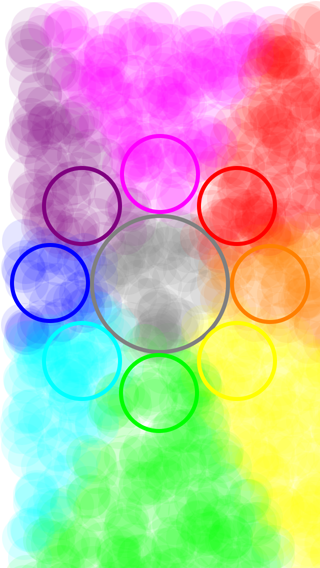Bayesian Touch Criterion
This project is maintained by fe9lix
BayesianTouchCriterion

Bayesian Touch Criterion
BayesianTouchCriterion is an Objective-C implementation of the Bayesian Target Criterion (BTC) developed by Xiaojun Bi and Shumin Zhai. Given a touch point and some touch targets, it improves the accuracy of selections by finding the touch target with the shortest Bayesian Touch Distance (BTD). This element is the one that the user intended to select. The results of the evaluation of Bi and Zhai show that selection based on BTC is much more precise than using the visual boundary of an element. (Visual boundary checking is how most touch frameworks determine if the finger touches a target.)
The image above shows how randomly placed touch points (the smaller, semi-transparent circles) select their corresponding targets (the nine big circles). In the user interface of a mobile app, for example, BTC could be used to more accurately determine which menu item the user intended to select. The point of using BTC instead of visual boundary checking is: The intended element is not necessarily the element where the user's touch lies exactly within the visual boundary of the element (e.g., the touch point might be somewhere slightly outside of the visual boundary). BTC has the advantage that it does not require more detailed information about the touch point (finger posture, touch area...). The only required input parameters of the formula are touch location, target center, and target diameter.
If you are interested in the full mathematical details and derivations, here's the full reference:
Xiaojun Bi and Shumin Zhai. Bayesian touch: A statistical criterion of target selection with finger touch. In Proceedings of the 26th Annual ACM Symposium on User Interface Software and Technology, UIST ’13, pages 51–60, New York, NY, USA, 2013. ACM.
The paper is freely available on Research at Google.
Installation
Just copy the folder src/BayesianTouchCriterion into your project.
The demo project shows a simple usage example. The code creates random touch points and determines the color of each touch point based on BTC (see image above). It also adds some interactivity: When you touch the screen, BTC finds the target layer of the circle menu and sets its background color to black.
Usage
There are just two simple classes: BTCCalculator and BTCFinder.
BTCFinder is more high-level and implements basic management for targets. Targets are of type CALayer (if you want to use views, just use a view's layer via view.layer). You can add and remove targets and find the intended target for a touch point.
Internally, BTCFinder uses BTCCalculator to calculate BTD. You can use BTCCalculator directly if you wish to implement your own logic for target management.
It's important that you set the PPI (points per inch) value for the target device before using either BTCFinder or BTCCalculator. Since BTC is based on millimeters, the PPI value is needed to convert from millimeters to pixels per inch and vice versa. (The demo project contains simple PPI detection for current iPhones and iPads.)
API
BTCFinder
You must set the PPI of the target device before using this class. Use hard-coded values or device detection logic.
+ (CGFloat)pointsPerInch;
+ (void)setPointsPerInch:(CGFloat)newPointsPerInch;
Add a CALayer as potential touch target, remove a layer, or remove all layers.
- (void)addTarget:(CALayer *)target;
- (void)removeTarget:(CALayer *)target;
- (void)removeAllTargets;
Find the target based on a touch point. The touch point must be located in the coordinate system of view.
- (CALayer *)findTargetForTouchPoint:(CGPoint)touchPoint
inView:(UIView *)touchView;
BTCCalculator
You must set the PPI of the target device before using this class. Use hard-coded values or device detection logic.
+ (CGFloat)pointsPerInch;
+ (void)setPointsPerInch:(CGFloat)newPointsPerInch;
Calculate BTD based on the touch point, the center point of the target and the diameter of the target. The target with the shortest BTD is the intended target. (You need to add this logic yourself if you use this class directly.)
+ (CGFloat)bayesianTouchDistanceWithTouchPoint:(CGPoint)touchPoint
targetCenter:(CGPoint)targetCenter
targetDiameter:(CGFloat)targetDiameter;
Important Notes
BTC works for circular target selection. The formula is based on target center and diameter. For objects with different shapes, you might need to check if you can use the diameter as an approximation and still achieve good results.
BTC assumes that each point selects one object on screen (i.e., it does not consider empty space between objects). You might need to add your own logic to select the final target.